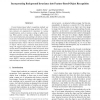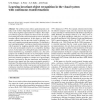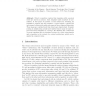276 search results - page 4 / 56 » Object Recognition by Implicit Invariants |
WACV
2005
IEEE
14 years 1 months ago
2005
IEEE
Current feature-based object recognition methods use information derived from local image patches. For robustness, features are engineered for invariance to various transformation...
BC
2006
13 years 7 months ago
2006
Abstract The cerebral cortex utilizes spatiotemporal continuity in the world to help build invariant representations. In vision, these might be representations of objects. The temp...
CLOR
2006
13 years 9 months ago
2006
We present a method for object categorization in real-world scenes. Following a common consensus in the field, we do not assume that a figure-ground segmentation is available prior...
IBPRIA
2007
Springer
14 years 1 months ago
2007
Springer
Object recognition requires that templates with canonical views are stored in memory. Such templates must somehow be normalised. In this paper we present a novel method for obtaini...
DAGM
2001
Springer
13 years 12 months ago
2001
Springer
Novel similarity measures for object recognition and image matching are proposed, which are inherently robust against occlusion, clutter, and nonlinear illumination changes. They c...



